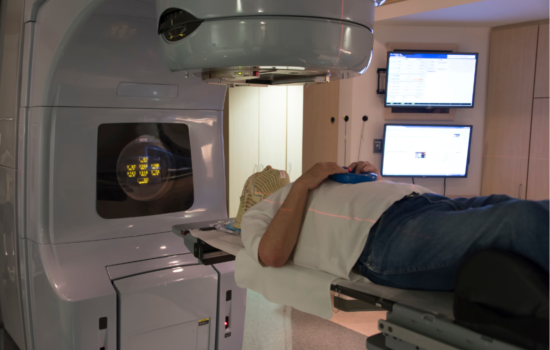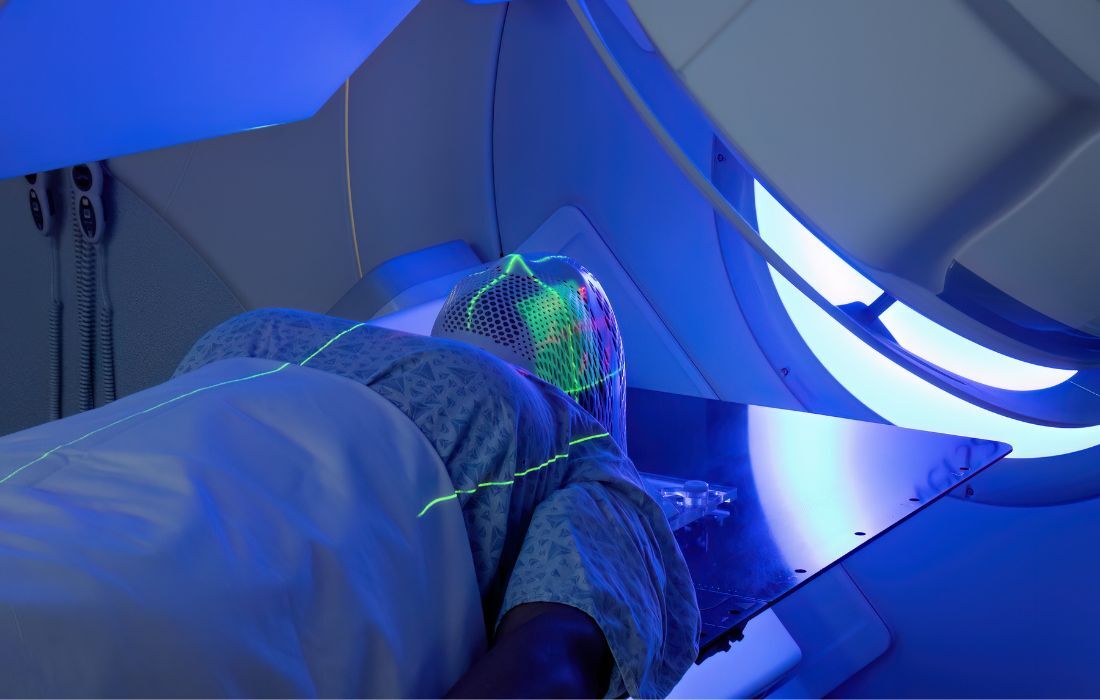July 9, 2025
Precision Cancer Treatment With Stereotactic Radiation Therapy

Radiation therapy is a common and effective method of treating cancer. It involves using high-energy beams or particles to target cancer cells, reducing the size of a tumor, alleviating unpleasant symptoms such as pain, and lowering the risk of cancer returning. It’s often used after surgery and can be given in combination with other cancer treatments, such as chemotherapy, targeted therapy, or hormone therapy.
At Cancer Care Centers of Brevard, patients have access to several types of radiation therapy, including the latest advancements called stereotactic radiosurgery (SRS) and stereotactic body radiation therapy (SBRT). These noninvasive forms of external beam radiation therapy deliver high doses of radiation with remarkable precision. Patients receive just a few treatments, resulting in fewer side effects and faster recovery times.
Understanding the Types of Stereotactic Radiation Therapy
There are two types of stereotactic radiation therapy: stereotactic radiosurgery and stereotactic body radiation therapy.
Stereotactic radiosurgery (SRS) is not surgery but a form of radiation therapy that uses focused radiation beams to target small tumors confined to the brain. This technique delivers precisely targeted radiation in fewer, higher-dose treatments than traditional radiation therapy. It may be used by itself or in combination with surgery. The precision of SRS reduces damage to surrounding brain tissue, making it a preferred choice for treating brain-related conditions that may be difficult to manage surgically.

When SRS is used to target tumors outside the brain, it is referred to as stereotactic body radiotherapy (SBRT). Like SRS, SBRT uses highly focused radiation beams to target tumors. Advanced imaging techniques allow doctors to accurately map the three-dimensional shape of the tumor and target it with minimal harm to healthy tissue in the area.
Key Differences Between SRS and SBRT
SRS and SBRT are similar in that they are precision treatments tailored to each individual’s needs. However, there are differences between them:
Area of treatment: SRS is primarily used to treat tumors in the brain or spine, while SBRT treats tumors outside the brain, particularly the lungs, spine, kidneys, and prostate.
Treatment schedule: SRS usually requires a single session. In contrast, SBRT may be administered over one to five sessions.
Your oncologist will help determine which treatment option is best for you.
What to Expect When Being Treated With SRS or SBRT
Before beginning stereotactic radiation therapy, your CCCB care team will determine the most suitable treatment method based on your type of cancer. The treatment team typically includes a radiation oncologist and other cancer specialists.
How Stereotactic Radiosurgery (SRS) is Administered
If you receive stereotactic radiosurgery (SRS), you will be placed in a precise and secure position for each session. Your radiation specialist may use a rigid frame or a custom-fitted mask to ensure your head stays still during the treatment.
Once positioned, the radiation team will map out the tumor's location using high-resolution imaging techniques, such as computed tomography (CT) or magnetic resonance imaging (MRI). Your oncology team will use these scans to ensure the radiation targets only the intended area. Multiple beams of radiation are then focused on the tumor with extreme precision. This can be accomplished using two advanced technologies:
Gamma Knife. This machine uses about 200 beams of radiation directed at the tumor from different angles while keeping the patient secured in a stationary position.
Linear accelerator (LINAC): This computer-controlled device moves around the patient to deliver radiation to the tumor from various angles.
How Stereotactic Body Radiotherapy (SBRT) is Administered
For stereotactic body radiation therapy, treatment simulation occurs before the actual procedure. The simulation lets your care team map out the cancerous area and create an appropriate treatment plan. Advanced imaging techniques will be used, such as CT, MRI, or PET scans.
Before treatment begins, you will be carefully positioned and immobilized using custom molds or frames. This is especially important because SBRT delivers radiation with high precision. Throughout the procedure, continuous imaging and monitoring will ensure you remain in the correct position and that the linear accelerator or other specialized machines deliver the radiation accurately. Adjustments can be made as necessary to accommodate any slight movements. The goal is to target the tumor while sparing the surrounding healthy tissue.
Stereotactic Radiation Treatments and Side Effects
SRS and SBRT are noninvasive procedures. Stereotactic radiosurgery requires only one session, and SBRT usually requires one to five treatments over the course of two weeks. Compared to standard radiation therapy, which involves treatments five days a week for 4-8 weeks, this is a huge step forward for patients. Your oncologist will likely schedule follow-up appointments to monitor the treatment's effectiveness and manage potential side effects.
Common side effects of stereotactic radiation therapy include tiredness or fatigue and skin issues such as irritation, redness, dryness, swelling, or itching at the treatment site. Patients receiving SBRT may experience additional symptoms depending on the location of their tumor. For example, SBRT for lung cancer might cause a mild cough, while patients undergoing treatment for prostate cancer may notice changes in bowel habits.
Types of Cancer Treated with SRS and SBRT
Both stereotactic radiosurgery and stereotactic body radiation therapy are effective, non-invasive treatment options that may benefit certain patients. Patients find it beneficial for treating cancers such as:
Tumors in the brain – this can be from brain cancer or cancer of another type that has spread to the brain.
Spine
Lung
Liver
Prostate
Pancreas
Head and neck cancers
The radiation oncologist will meet with you to discuss the number of treatments and the goals of your treatment.
Cancer Treatment With Radiation Therapy Available in Brevard County
The cancer specialists at Cancer Care Centers of Brevard (CCCB) understand the importance of treating each patient according to their unique needs. We take time to evaluate your specific type and stage of cancer to ensure a customized treatment plan that will achieve optimal results.
If you’re located in Brevard County, Florida, and will receive radiation therapy as part of your cancer treatment plan, choosing a radiation oncologist at a cancer center close to home or work is important. Request an appointment with an oncologist at a CCCB location that is most convenient for you to learn more about radiation for cancer treatment, including stereotactic radiosurgery and stereotactic radiation therapy, or to get a second opinion.
Categories: Cancer Treatments, Radiation Therapy